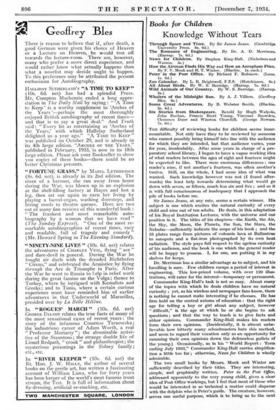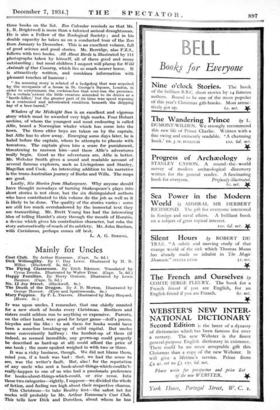Books for Children
Knowledge Without Tears
The Romance of Engineering. By Dr. A. D. Merriman. (Harrap. 7s. 6d.) How the Airman Finds His Way and How an Aeroplane Flies.
By F. V. Monk and H. T. Winter. (Blackie. Is. each.) Peter in the Post Office. By Richard F. Robinow. (Lane.
Is. 6d.) 5s.)
Tim difficulty of reviewing books for children seems insur- mountable. Not only have. they to be reviewed by someone who cannot possibly bring himself into line with the audience for which they are intended, but that audience varies, year for year, incalculably.. After some years in charge of a pre- paratory school library, I began to have a vague working idea of what readers between the ages of eight and fourteen might be expected to like. There were enormous differences : one reader's nine, if not another's fourteen, was often another's twelve. Still, on the whole, I had some idea of what was wanted. Such knowledge however was not (I found after- wards) the least help towards determining what would go down with seven, or fifteen, much less six and five ; and so it is with full consciousness of inadequacy that I approach the -pile of books before me.
Sir James Jeans, at any rate, seems a certain winner. His subject is one which excites the natural curiosity of every child and nine out of ten adults. He deals, in this adaptation of his Royal Institution Lectures, with the universe and our position in it. The titles of his chapters—the Earth, the Air, the Sky, the Moon, the Planets, the Sun, the Stars, the Nebulae—sufficiently indicate the scope of his book ; and the 53 plates range from pictures of volcanic lava at Ballantrae to sunspots and a flat-iron photographed by its own heat radiation. The style pays full respect to the ageless curiosity of his audience, and the book is one which the general reader will be happy to possess. I, for one, am putting it in my shelves for keeps.
Dr. Merriman has a similar advantage as to subject, and his handling is sure. Few children escape a period of interest in engineering. This low-priced volume, with over 120 illus- trations, will cater for the interest—temporary or permanent.
Commander King-Hall's task is not so easy. About many of the topics with which he deals children have no natural curiosity ; yet, as his wireless and newspaper fans know, there is nothing he cannot make interesting if he chooses. He has firm hold on the central axioms of education : that the right age for telling a boy or girl about any subject, however " difficult," is the age at- which he or she begins to ask questions ; and that the way to teach is to give facts and abhor opinions. Commander King-Hall makes his readers form their own opinions. (Incidentally, it is almost unbe- lievable how bitterly many schoolmasters hate this method, and seem to regard their Vocation only as an opportunity for ramming their own opinions down the defenceless gullets of the young.) Occasionally, as in his " World Report : Term ending July 1933," Commander King-Hall carries simplifica- tion a little too far ; otherwise, News for Children is wholly admirable.
The two small books by Messrs. Monk and Winter are sufficiently described by their titles. They are interesting, simple, and graphically written. Peter in the Post Office, addressed apparently to the very young child, gives a clear idea of Post Office workings, but I feel that most of those who would be interested in so technical a matter could dispense with the dolphin who is Peter's guide. The creature, however, serves one useful purpose, which is to bring us to the next three books on the list. Zoo Calendar reminds us that Mr. L. R. Brightwell is more than a talented animal draughtsman. He is also a Fellow of the Zoological Society ; and in his double capacity he takes us on a conducted tour of the Zoo from January to December. This is an excellent volume, full of good science and good stories. Mr. Berridge, also F.Z.S., follows with two books. AU About Birds is illustrated by 111 photographs taken by himself, all of them good and many outstanding ; but most children I suspect will plump for Wild Animals of Our Country, which lies so much nearer home. It is attractively written, and combines information with pleasant touches of humour : " An amusing story is related of a hedgehog that was acquired by the occupants of a house in St. George's Square, London, in order to exterminate the cockroaches that over-ran the premises. To a certain'exient the little creature attended to its duties as a beetle-killer,' but the greater part of its time was spent reposing in a contented and intoxicated condition beneath the dripping tap of a beer-barrel."
Whalers of the Midnight Sun is an excellent and vigorous story which must be awarded very high marks. Four Hobart urchins, of whom the youngest and most endearing is called Alfie, board a Norwegian whaler which has come into the town. The three elder boys are taken on by the captain, but Alfie has to stow away. Emerging some days later, he is haled before the captain, whom he attempts to placate with tomatoes. The captain gives him a scare for punishment, threatening to maroon him—and there Alfie's adventures really begin. Good as the adventures are, Alfie is better. Mr. Webster Smith gives a sound and readable account of several famous explorers, such as Livingstone and Stanley, Magellan and Cook. An interesting addition to his narrative is the trans-Australian journey of Burke and Wills. The maps are good.
Lastly, Six Stories from Shakespeare. Why anyone should have thought nowadays of turning Shakespeare's plays into short stories is not clear, but the six distinguished authors who have contributed to this volume do the job as well as it is likely to be done. The quality of the stories varies : some are still too much overshadowed by the immortal text they are transcribing. Mr. Brett Young has had the interesting idea of telling Hamlet's story through the mouth of Horatio, a device which gives his contribution character, but robs the story automatically of much of its subtlety. Mr. John Buchan, with Coriolanus, perhaps comes off best.
L. A. G. STRONG.



















































 Previous page
Previous page